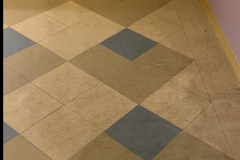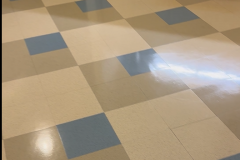Hey Friends! at Revive Carpet Cleaning! We do expert VCT Cleaning, Sealing & Waxing on your commercial floors to bring them back to shiny & beautiful floors! Below is a job we did for a client in West Hollywood, he was thrilled.
<—–Ready To Start? Fill Out This Intake Form
How do you Clean, Seal & Wax VCT floors?
Cleaning, sealing, and waxing Vinyl Composition Tile (VCT) floors require specific steps to maintain their appearance and durability. Here’s a guide on how to clean, seal, and wax VCT floors:
Cleaning VCT Floors:
- Remove loose dirt: Sweep or vacuum the floor to remove loose dirt, dust, and debris. Use a broom or a vacuum cleaner with a soft brush attachment.
- Prepare a cleaning solution: Mix a pH-neutral floor cleaner with warm water according to the manufacturer’s instructions. Avoid using abrasive or acidic cleaners that can damage the VCT.
- Mop the floor: Dip a mop into the cleaning solution, wring out any excess liquid, and mop the floor in small sections. Start from one end of the room and work your way to the other, ensuring you cover the entire floor.
- Address stubborn stains: For stubborn stains, apply a small amount of undiluted cleaner directly to the spot. Let it sit for a few minutes, then scrub gently with a soft nylon brush or non-abrasive pad. Rinse thoroughly with clean water.
- Rinse the floor: After mopping, rinse the floor with clean water to remove any residue from the cleaner. Ensure all cleaning solution is thoroughly removed.
Sealing VCT Floors:
- Ensure the floor is clean and dry: Make sure the VCT floor is completely free of dirt, dust, and moisture before applying the sealer. Allow the floor to dry completely after cleaning.
- Choose the appropriate sealer: Select a high-quality acrylic floor sealer suitable for VCT floors. Read the manufacturer’s instructions for specific application guidelines.
- Apply the sealer: Pour the sealer into a paint tray or bucket. Use a clean microfiber mop or a synthetic wax applicator to apply a thin and even layer of sealer to the floor. Work in small sections, overlapping each pass to ensure complete coverage.
- Allow drying time: Follow the manufacturer’s instructions regarding drying time. It typically takes several hours for the sealer to dry completely.
Waxing VCT Floors:
- Choose the appropriate wax: Select a high-quality commercial floor wax specifically designed for VCT floors. Check the manufacturer’s instructions for compatibility with the sealer you used.
- Apply the wax: Pour a small amount of wax onto the floor and spread it evenly using a clean mop or applicator. Work in small sections, applying a thin and even layer of wax. Avoid over-application, as this can lead to a sticky residue.
- Allow drying time: Allow the wax to dry according to the manufacturer’s instructions. It usually takes several hours or overnight.
- Buff the floor (optional): For an enhanced shine, use a floor buffer with a soft pad to gently buff the waxed surface. Follow the manufacturer’s instructions and exercise caution to avoid damaging the floor.
Regular Maintenance: To maintain the cleanliness and appearance of your VCT floors, follow these regular maintenance tips:
- Sweep or vacuum the floor daily to remove dirt and debris.
- Clean up spills promptly to prevent stains.
- Avoid using harsh chemicals, abrasive tools, or excessive water when cleaning.
- Periodically damp mop the floor with a pH-neutral floor cleaner to remove dirt and maintain the shine.
- Reapply wax as needed to restore the protective layer and enhance the floor’s appearance.
Note: Always follow the manufacturer’s instructions provided with the cleaning products, sealers, and waxes you use. Additionally, consider wearing protective gloves and ensuring adequate ventilation when working with these products.


